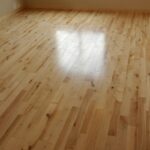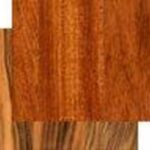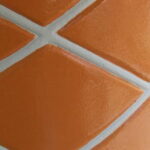One of the advantages of installing linoleum flooring squares in a kitchen is the ability to design a custom pattern that suits your personality and your house. Unlike the old days where linoleum floors tended to be a shade of yellow or brown, today’s homeowners can choose from a wide palette of colors to match every decor. If you’re after a retro look in your home, brightly colored linoleum squares might be the perfect solution.
Lineolum flooring squares, such as the type made by Marmoleum and Forbo, are a commercial product and usually only available through commercial flooring dealers. They come in several sizes including 12 inch square, 20 inch square, and even a 12″ x 36″ rectangle. Don’t let the “commercial” part scare you; these linoleum tiles look fantastic in residential homes. The 12 inch squares comes packaged nine to the box, which means that designing a multi color floor with a retro look doesn’t cost a home owner extra money.
Single color patterned floor
Unlike ceramic tiles, linoleum tiles are not really just a single color. Linoleum is made up of a composite of colors with one color being more predominant than the rest. A yellow tile for example may have tiny flecks or striations of turquoise, red, and brown that run in the same direction. It’s the composition of colors that give linoleum a warmth that usually isn’t found in a ceramic tile floor.
But because of the striations, special care needs to be taken when putting down tiled linoleum. Rather than matching up the striations (which looks quite odd) the tiles are alternated. One tile should have the striations running from side to side, with the alternating tile striations running up to down. This alternation of single color tiles is a subtle pattern that looks great in rooms where you might want the focus of attention on the walls instead of the floor.
For a single color kitchen floor, some authentic 50s and 60s colors were red, pale pink, yellow, slate, and blue. For older homes from the 1920-40s, popular colors included dark green, ochre, umber, orange, light yellow, and light grey.
Multi color retro patterns
Multi color retro patterns are the most popular application of linoleum flooring squares for the home. Some homeowners prefer alternating two different colors which is the type of floor we used to see in old restaurants and soda shops. Whether you want to use two colors or more to achieve that retro look in your home, it’s always best to do a little experimenting with colored crayons first.
When we designed the multicolored floor of our retro kitchen, we practiced color combinations on a piece of grid paper first. This was done by drawing the kitchen to scale on the grid paper with every four squares equaling one foot. Once the kitchen “blueprint” was drawn, 20 copies were printed to experiment with. To color the tiles, we used a 64 count box of fresh Crayola crayons. It was really that simple!
There’s no rhyme nor rule to creating a retro looking pattern. Alternating two colors of tiles with a random third or fourth color scattered through out is one of the more popular of the multicolor retro approaches. Another idea is to use one color around the perimeter of the room, and a second color in the middle, which is more of a 1910-40s look. A basket weave design is also a popular alternative. For our kitchen, we went really wild and defined the perimeters of the room with one color, the middle of the room in a second color, and used a third color to define the eating areas and pantries for a retro 1950s look.
Kitchen and commercial floor colors of the 1950s included such combinations of red and white, red and yellow, pink and white, black and white, brown and yellow, and grey and white. If my house is any indicator of 1920s and 1930s floor color combinations, green and yellow, green and white, and slate grey and yellow were some of the popular colors of that era.
Designing a pattern for a retro linoleum floor really isn’t that tough. With a book of grid paper and a box of new Crayolas, you can experiment away with color combinations until you reach a pattern that works for you. Once the basic concept design has been drawn, the installation team can follow the design scheme to bring your idea to life. For more ideas for designing your retro floor pattern, visit your local library for back issues of women’s magazines of the 1940s-1960s. Vintage magazines are a great resource for learning which linoleum color combinations were the most popular during this era.



